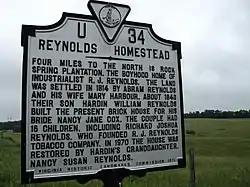Reynolds Homestead
The Reynolds Homestead, also known as Rock Spring Plantation, is a historic plantation on Homestead Lane in Critz, Virginia. First developed in 1814 by Abraham Reynolds, it was the primary home of R. J. Reynolds (1850-1918), founder of the R. J. Reynolds Tobacco Company, and the first major marketer of the cigarette. It was designated a National Historic Landmark in 1977.[1][3][5] The homestead is currently an outreach facility of Virginia Tech, serving as a regional cultural center. The house is open for tours.
Reynolds Homestead | |
 Historic marker for Reynolds Homestead | |
  | |
| Location | N of Critz on SR 798 |
|---|---|
| Coordinates | 36°38′39″N 80°8′55″W |
| Area | 6.99 acres (2.83 ha)[1] |
| Built | 1850 |
| Architect | Reynolds, Hardin W. |
| Architectural style | Greek Revival |
| NRHP reference No. | 71000987 |
| VLR No. | 070-0005 |
| Significant dates | |
| Added to NRHP | September 22, 1971[2] |
| Designated NHL | December 22, 1977[3] |
| Designated VLR | November 3, 1970[4] |
Description and history
The Reynolds Homestead is located in a rural area of eastern Patrick County, Virginia, about one mile north of the village of Critz. The estate house is a two-story brick building with a hip roof, from which an older two-story ell extends. Outbuildings of the plantation complex include a large corn crib, a brick kitchen, milkhouse, and icehouse. The Reynolds family cemetery is located near the house and across a field is the slave cemetery. The house has been restored to its nineteenth century state and includes many of the original family furnishings.[1]
The property was first developed by Abraham Reynolds, who built a log cabin near where the main house stands. His son, Hardin W. Reynolds, developed the estate in the mid-19th century, and it here that his son, R. J. Reynolds was born and lived for the first 24 years of his life. Reynolds achieved early economic success selling plug tobacco, but made an instant success out of the introduction of the Camel cigarette brand, which he marketed and advertised widely.[1]
Reynolds moved out of the family homestead in 1874. It remained within the family, but in declining condition, into the mid-20th century. In 1968, Mrs. Nancy Susan Reynolds, R.J.'s only surviving child, purchased over 700 acres (280 ha) of the original plantation, most of which she gave to Virginia Tech, retaining life interest in the homestead, which was carefully restored.[1] The property is now managed by Virginia Tech, and includes a continuing education center managed by its Department of Outreach and International Affairs. It hosts educational and cultural events, and the house is open for tours for both individuals and groups.
See also
References
- Ralph J. Christian (December 1976). "National Register of Historic Places Inventory-Nomination: Reynolds Homestead / Rock Spring Plantation" (pdf). National Park Service. Cite journal requires
|journal=(help) and Accompanying four photos, exterior and interior, from 1976 (32 KB) - "National Register Information System". National Register of Historic Places. National Park Service. January 23, 2007.
- "Reynolds Homestead". National Historic Landmark summary listing. National Park Service. Retrieved 2008-04-21.
- "Virginia Landmarks Register". Virginia Department of Historic Resources. Retrieved 5 June 2013.
- Virginia Historic Landmarks Commission Staff, James W. Moody, Jr., Director (October 21, 1970). "National Register of Historic Places Inventory-Nomination: Reynolds Homestead / Rock Spring Plantation" (pdf). National Park Service. Cite journal requires
|journal=(help)CS1 maint: multiple names: authors list (link)
External links
| Wikimedia Commons has media related to Reynolds Homestead. |


